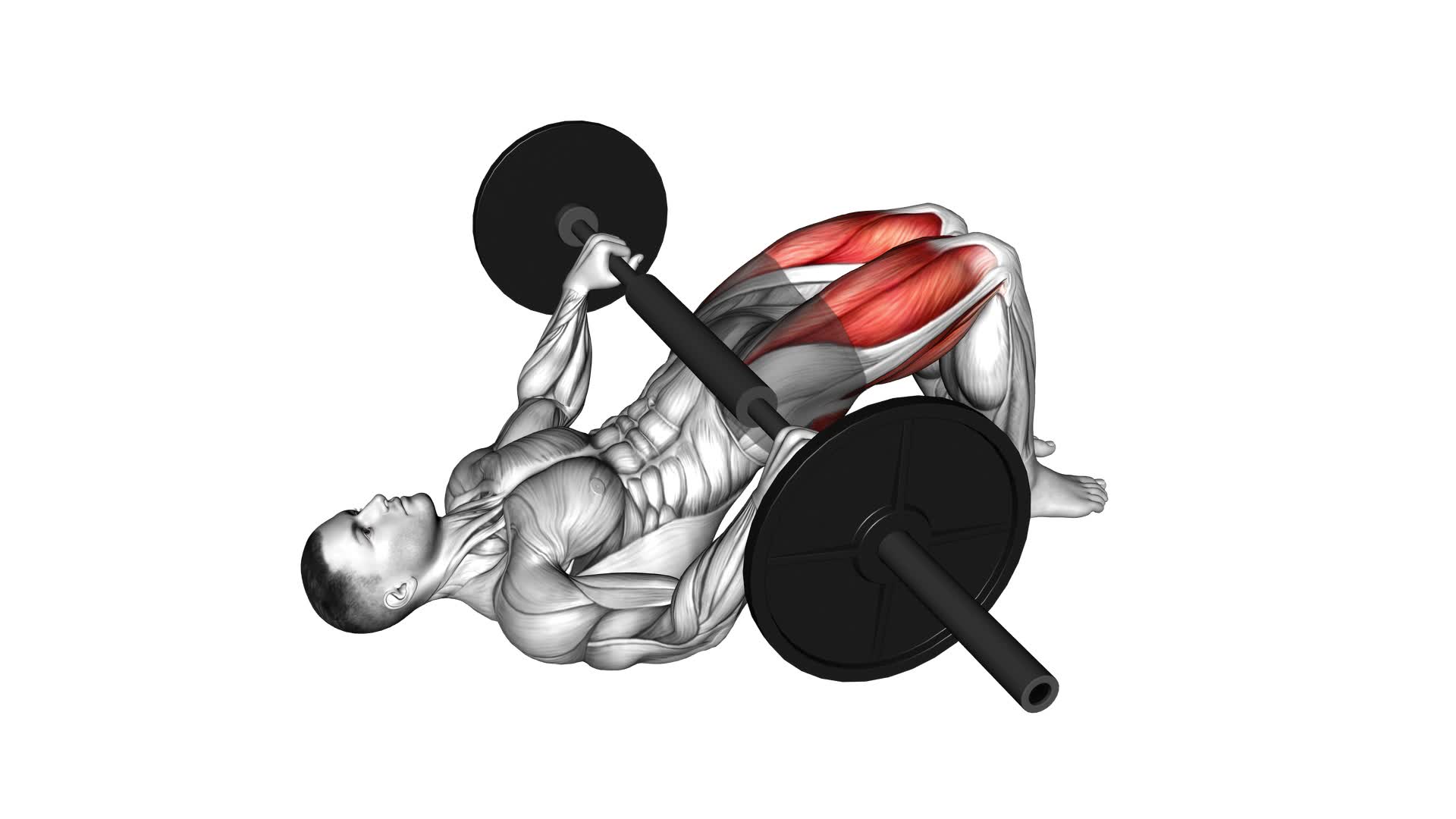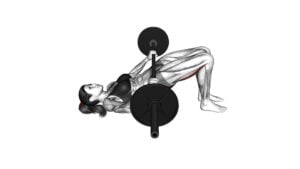Barbell Glute Bridge (Hands on Bar) – Video Exercise Guide & Tips

Get ready to strengthen your glutes with the barbell glute bridge!
Watch This Exercise Video
This exercise guide and tips video will show you the proper form and technique for performing this effective move.
Whether you're a beginner or advanced, there are variations to suit your fitness level.
Avoid common mistakes and maximize glute activation with our expert tips.
Let's get started on sculpting those glutes and achieving your fitness goals!
Key Takeaways
- Barbell glute bridge activates and strengthens glute muscles.
- It targets gluteus maximus, medius, and minimus.
- It shapes and tones buttocks.
- It improves hip mobility and stability.
Benefits of Barbell Glute Bridge
Get ready to discover the amazing benefits of the Barbell Glute Bridge for your glutes, using your own body weight and a barbell. The Barbell Glute Bridge is one of the best exercises for glute activation and can be modified to suit different fitness levels and goals.
One of the key benefits of the Barbell Glute Bridge is its ability to activate and strengthen the glute muscles. By using the barbell, you can increase the resistance and challenge your glutes even more. This exercise targets the gluteus maximus, medius, and minimus, helping to shape and tone your buttocks.
Another advantage of the Barbell Glute Bridge is its versatility. You can easily modify the exercise to suit your needs. For beginners or those with limited mobility, using just your body weight can still provide a great workout. As you progress, you can add weights to the barbell or even use resistance bands to increase the challenge.
Additionally, the Barbell Glute Bridge helps to improve hip mobility and stability. It engages your core muscles and strengthens your lower back, which can help alleviate lower back pain and improve posture.
Proper Form and Technique
To perform the Barbell Glute Bridge with proper form and technique, follow these steps:
- Position yourself on the ground with your back flat and feet shoulder-width apart. Place a barbell across your hips, gripping it with both hands.
- Engage your core and squeeze your glutes as you lift your hips off the ground, using your heels to push through the floor. Keep your knees in line with your toes and your back straight throughout the movement.
- As you reach the top of the movement, pause briefly and focus on squeezing your glutes as hard as possible.
- Slowly lower your hips back down to the starting position, maintaining control and keeping tension in your glutes.
Common cues for proper form include keeping your core engaged, maintaining a neutral spine, and not allowing your knees to cave inwards. It's important to focus on muscle activation in the glutes throughout the exercise to ensure maximum effectiveness.
By following these steps and cues, you can perform the Barbell Glute Bridge with proper form and technique, maximizing the activation of your glute muscles.
Now, let's move on to the next section and explore variations of the Barbell Glute Bridge for different fitness levels.
Variations for Different Fitness Levels
As you progress in your fitness journey, there are various modifications of the Barbell Glute Bridge that cater to different levels of strength and experience. For beginners, it's important to start with proper form and technique before advancing to more challenging variations.
One beginner modification is to perform the exercise without any added weight. This allows you to focus on activating your glutes and mastering the movement pattern. Another modification is to use a resistance band around your knees to provide additional support and stability. This can help you maintain proper alignment and engage your glutes more effectively.
For those who are more advanced and looking for a greater challenge, there are several options to consider. One advanced modification is to elevate your feet on a bench or step. This increases the range of motion and places more emphasis on your glutes. Another option is to perform the exercise with a single leg. This requires greater stability and strength, as well as increased activation of the glute muscles.
Common Mistakes to Avoid
To prevent common mistakes, it's crucial to consistently focus on proper form and technique during the Barbell Glute Bridge exercise. Paying attention to the proper setup and avoiding hyperextension will help you get the most out of this exercise while minimizing the risk of injury. Here are some common mistakes to avoid:
- Improper foot placement: Make sure your feet are hip-width apart and firmly planted on the ground. This will provide a stable base of support and allow for better activation of the glutes.
- Lifting too high: Avoid the temptation to lift your hips too high during the movement. This can lead to hyperextension of the lower back and take the emphasis away from the glutes. Instead, aim for a controlled and smooth movement, focusing on squeezing your glutes at the top of the bridge.
- Neglecting core engagement: Engaging your core is essential for maintaining stability and protecting your lower back. Before starting the exercise, activate your core muscles by drawing your belly button towards your spine.
- Using excessive weight: While it's important to challenge yourself, using too much weight can compromise your form and increase the risk of injury. Start with a manageable weight and gradually increase as your strength improves.
Tips for Maximizing Glute Activation
To maximize glute activation, focus on driving through your heels during the Barbell Glute Bridge exercise. This simple adjustment can make a significant difference in targeting and activating your glute muscles. By pushing through your heels, you engage the posterior chain, including the hamstrings and glutes, more effectively.
In addition to driving through your heels, there are other tips that can help maximize glute activation during glute bridge exercises. First, make sure to maintain a neutral spine throughout the movement. Avoid arching your back or tucking your pelvis too much, as this can shift the focus away from the glutes.
Another important tip is to squeeze your glutes at the top of the movement. This helps to further activate the glute muscles and increase the intensity of the exercise. Additionally, using a challenging weight or resistance band can also enhance glute activation.
To get the most out of your glute activation exercises, it's important to incorporate a variety of glute workouts into your routine. Some of the best glute workouts include hip thrusts, lunges, squats, and deadlifts. By incorporating these exercises and focusing on proper form and technique, you can effectively target and activate your glutes for maximum results.
Frequently Asked Questions
How Much Weight Should I Start With When Doing the Barbell Glute Bridge?
When starting the barbell glute bridge, it's important to consider your strength level and experience. Begin with a weight that challenges you, but allows you to maintain proper form.
As you progress, gradually increase the weight to continue challenging your muscles. If you're a beginner, you can modify the exercise by using just your body weight or starting with a lighter barbell.
Remember to always listen to your body and progress at a pace that feels comfortable for you.
Can I Do the Barbell Glute Bridge Without a Barbell?
Yes, you can do alternative exercises for the barbell glute bridge if you don't have a barbell.
However, it's important to note that the barbell glute bridge offers unique benefits.
It specifically targets the glute muscles and can help improve strength and stability.
If you don't have a barbell, you can try using dumbbells or resistance bands to add resistance to the exercise.
Remember to focus on maintaining proper form and gradually increasing the weight or resistance as you progress.
Is It Necessary to Have Someone Spot Me While Performing the Barbell Glute Bridge?
It's not necessary to have someone spot you while performing the barbell glute bridge. Spotting benefits for this exercise are minimal since it primarily targets the glute muscles.
However, if you prefer having a spotter for added safety, you can ask a training partner or gym staff to assist you.
Alternatively, if you don't have access to a barbell, you can try other variations of the glute bridge using dumbbells, resistance bands, or bodyweight exercises.
How Often Should I Include the Barbell Glute Bridge in My Workout Routine?
To maximize the benefits of incorporating the barbell glute bridge into your workout routine, it's important to perform it regularly. Adding this exercise to your routine 2-3 times a week can help strengthen and tone your glutes, hamstrings, and core muscles.
To make it more challenging, you can try variations like single-leg or banded glute bridges. Remember to maintain proper form and gradually increase the weight to continue progressing.
Are There Any Specific Warm-Up Exercises I Should Do Before Attempting the Barbell Glute Bridge?
Before attempting the barbell glute bridge, it's important to warm up your muscles and activate the glutes. Incorporating dynamic stretches like leg swings and hip circles can help loosen up the hips and increase mobility.
Activation exercises such as clamshells and glute bridges with a resistance band can also help activate the glutes and prepare them for the barbell glute bridge.
These warm-up exercises will help improve your performance and prevent injuries during the workout.
Conclusion
In conclusion, the barbell glute bridge is a highly effective exercise for targeting and strengthening the glute muscles. By maintaining proper form and technique, individuals can maximize the benefits of this exercise.
Additionally, variations can be incorporated to accommodate different fitness levels. It's important to be aware of common mistakes to avoid in order to prevent injury.
By following these tips, individuals can optimize glute activation and enhance their overall fitness routine.

Author
Years ago, the spark of my life’s passion ignited in my mind the moment I stepped into the local gym for the first time. The inaugural bead of perspiration, the initial endeavor, the very first surge of endorphins, and a sense of pride that washed over me post-workout marked the beginning of my deep-seated interest in strength sports, fitness, and sports nutrition. This very curiosity blossomed rapidly into a profound fascination, propelling me to earn a Master’s degree in Physical Education from the Academy of Physical Education in Krakow, followed by a Sports Manager diploma from the Jagiellonian University. My journey of growth led me to gain more specialized qualifications, such as being a certified personal trainer with a focus on sports dietetics, a lifeguard, and an instructor for wellness and corrective gymnastics. Theoretical knowledge paired seamlessly with practical experience, reinforcing my belief that the transformation of individuals under my guidance was also a reflection of my personal growth. This belief holds true even today. Each day, I strive to push the boundaries and explore new realms. These realms gently elevate me to greater heights. The unique combination of passion for my field and the continuous quest for growth fuels my drive to break new ground.







